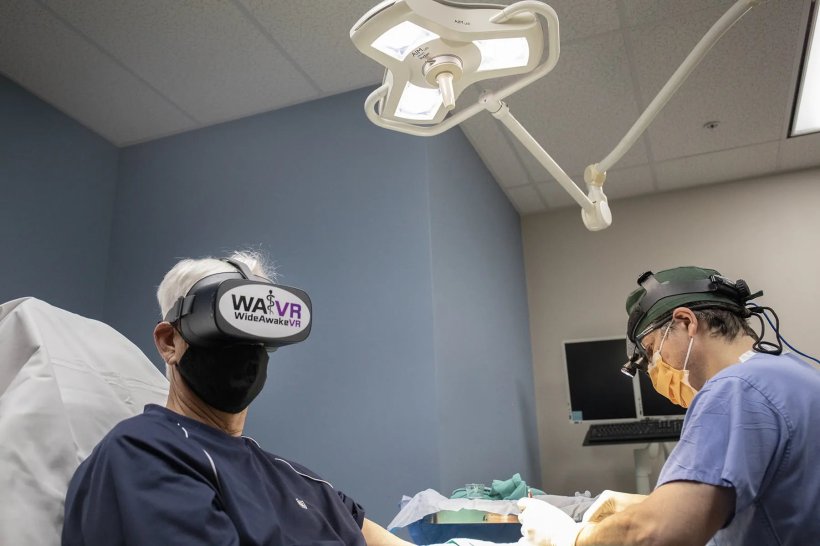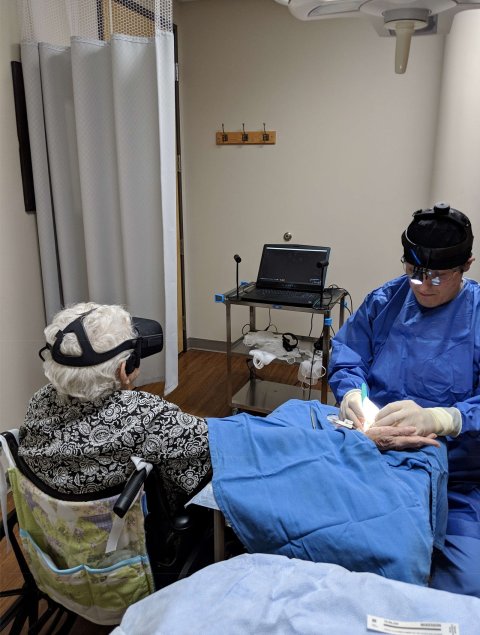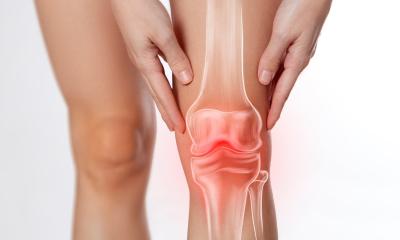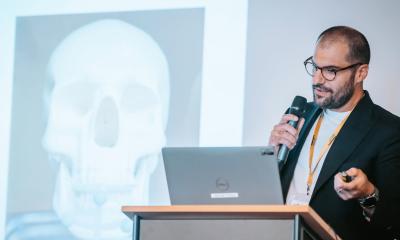
Image source: Michigan State University
News • Virtual distraction
Use of VR during wide-awake surgery helps ease anxiety
Picture the breathtaking aerial view of Victoria Falls in Zambia — watch as water falling more than 300 feet into a seemingly endless abyss comes into focus and listen to the soothing sounds of soft music playing in the background. Relax as steam billows from the waterfall that natives call Mosi-oa-Tunya, “the smoke that thunders.”
Seated in a procedure room in East Lansing and wearing a set of virtual reality goggles, patient James Klunzinger, 79, finally stops fidgeting as he becomes immersed in the experience, his left arm extended as his doctor, James Clarkson cleans and preps his hand for a carpal tunnel release surgery.
Less than 20 minutes later, Klunzinger walks out of the room, his left hand wrapped in bandages, with a smile on his face. “That was a lot better than having to watch the surgery,” he says. “It was distracting, which is good. I would give it a thumbs up.” Like Klunzinger, patients immersed in VR, or virtual reality, while undergoing wide-awake surgery experience more joy and less anxiety than those who underwent the surgery in a traditional operating room setting, according to a study from Michigan State University (MSU) published in the journal Plastic and Reconstructive Surgery.
Image source: Unsplash/Sammy Wong
“For patients immersed in the VR experience, we definitely saw an increase in joy,” said James Clarkson, the senior author of the study and an assistant professor of surgery at Michigan State University College of Human Medicine. “And for patients with an anxiety disorder, we saw decreased anxiety and their joy levels significantly increased,” said Clarkson, a hand surgeon at MSU Health Care.
Researchers wanted to compare patients who had undergone a traditional carpal tunnel release surgery in a hospital, requiring monitored anesthesia care or general anesthetic against those who had the surgery while awake, using local anesthesia with no tourniquet in the office environment and with the option of having a virtual reality immersion.
In a retrospective study, the researchers looked at 404 patients who had procedures at three locations in Michigan between August 2017 and March 2021. The survey showed that patients who went through a traditional surgery in an operating room were twice as likely to report a neutral or negative experience compared to patients who had the awake surgery (23% versus 11%). Patients undergoing traditional surgery also reported significantly lower enjoyment scores (44% versus 20%) and higher anxiety (42% versus 26%).
Patients who had the awake surgery in an office setting and opted to use VR experienced higher enjoyment than those who did not use VR (85% versus 73%). Patients reporting an anxiety disorder were more likely to choose the VR experience and, when they did, they experienced decreased anxiety (79% versus 47%) and increased enjoyment (90% versus 59%).

Image source: McKenzie et al., Plastic and Reconstructive Surgery 2022 (CC BY-NC-ND 4.0)
Clarkson said a few years back, doctors in Canada developed a method for carpal tunnel release surgery that avoided using a tourniquet — sidestepping the need for a hospital operating room, costly procedures, patient fasting and anesthesia requirements and a post-procedure driver for the patient. But time and again, Clarkson’s patients rejected the idea of being awake during the surgery, preferring to be put to sleep instead. “The patients were saying ‘just put me out, doc; I don't want to know anything about it.’ We were still putting them through these incredibly expensive, time-consuming, sterile procedures in major hospital settings.”
In 2016, Clarkson was watching his children play at home with a VR system when he realized a potential solution right in front of him. “I had an immediate sense of ‘this is exactly what my patients need,’” said Clarkson, who had been looking for ways to keep his patients awake and distracted during the surgery. “I could tell them, ‘I won’t put you out, but I can put you somewhere else.’”
After that initial “aha!” moment, Clarkson went on to study the effect of patients using VR and published a trial. He was later approached by others interested in the development of this technology and, together, they started the company Wide Awake VR to adapt its use for surgical needs. “VR transformed the experience of the patient,” he said. “They no longer had to starve from midnight, and they could drive the same day — have surgery and go home just like you do with the dentist.”
Carpal tunnel is a narrow passageway of bones and ligaments at the base of the palm, including the media nerve, which runs from the forearm into the palm. When this middle nerve becomes squeezed at the wrist, it leads to sensation of ‘pin and needles,’ pain and tingling. If left untreated, carpal tunnel syndrome can cause atrophy of the nerves. Often, the condition is treated by resting and immobilizing the hand, pain medication and by treating underlying conditions, but in the most extreme cases surgery is needed.
Back in East Lansing and as Clarkson and a nurse prepared for the procedure, Klunzinger donned the VR goggles and started watching a tour of the International Space Station. However, Klunzinger still seemed uncomfortable, turning his head to follow movement in the space station and stretching his left hand to relieve the pain. “Would you like me to take you to East Africa instead? You don’t strike me as a NASA guy,” Clarkson says, indicating to the nurse to change the VR experience on a nearby iPad. “Is that better?” Clarkson asks as the iPad lights up, showing the vibrant colors of a rainbow that now shines over the waterfall. With the VR goggles, Klunzinger sees the same video and smiles, finally calming down. “It’s not the Masters, but it will do,” he says as Clarkson makes an incision about an inch long near the base of the palm to begin the procedure.
A few stiches later, Klunzinger is ready to leave. In two weeks, he will return for a checkup, and if things don’t work out the way he hopes, he’ll have to undergo surgery on his right hand next. If that’s the case, he says he will choose the VR experience again. “It really was something else,” he adds, gathering his personal items and getting ready to drive himself home.
Source: Michigan State University
07.03.2023











